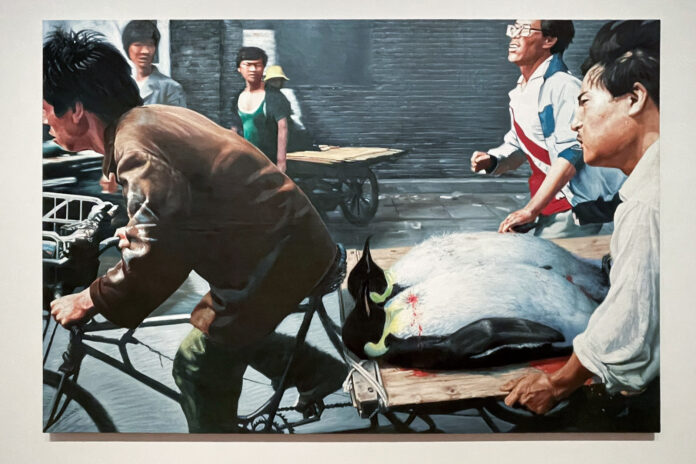
Opened to the Hong Kong public for less than two months in 2021, M+ has already removed several controversial paintings from its Sigg Collection galleries ahead of its reopening following the Omicron wave on April 21, raising new concerns about the public display of historical artworks in China.
The most direct of these works, Wang Xingwei’s photorealistic painting The New Beijing (2001), satirically alludes to censorship in connection with the brutal crackdown on student demonstrations in 1989 in Beijing’s Tiananmen Square. The work is based on a journalistic photograph by Liu Heung Shing showing injured protesters being taken to the hospital on the back of a cart, with two of the wounded replaced in Wang’s painting by human-sized penguins.
The museum also removed from public view Wang Guangyi’s Mao Zedong: Red Grid No. 2 (1989), which analyzes the propaganda regime of official images and was painted during the Beijing Spring. Similar versions of this radically deconstructed portrait of Mao were among the most controversial works displayed in the police-closed China/Vanguard exhibition of 1989 at the National Art Museum of China in Beijing, to which part of the Sigg Collection Gallery was dedicated.
In a statement provided to ArtAsiaPacific, representatives from the West Kowloon Cultural District Authority (WKCDA), which oversees M+, said “M+ has always planned to rotate over 200 artworks in its first year of opening” and that “nine of the over 200 [artworks] were rotated before the opening, in particular those that are more in need of preservation.
While the Sigg Collection galleries were not undergoing a major overhaul during the museum’s closure, some of the replaced paintings were replaced with noticeably fewer political pieces by the same artists – rather than representing artists whose work was not originally on display, of the more than 1,500 works donated M+ by Swiss collector Uli Sigg.
New Beijing has been replaced by Wang Xingwei’s Saint Thomas (1997), a postmodern pastiche of European baroque painting in which two Andy Warhol- and Joseph Beuys-like police officers watch a crouched figure break through a wooden door – the latter reference to painting by Marcel Duchamp final installation, Ethan Donnet (1946–66).
Mao Zedong said that “Red Grid No. 2” was replaced by a painting with a similar superimposed grid structure and the letters “A” and “O” (Rationality in Ordinary Behavior) (1988), which depicts an ambiguous human figure and a urinal (another Duchamp’s example), rather than the infamous image of Mao from official portraiture.
Of the nine works sent back to the vault, another was Zhou Tiehai’s “Press Conference III” (1996), celebrating China’s tense international cultural and diplomatic ties, with the figure of the artist standing at the press conference in front of a row of flags and a subtitle with the sentence “Relations in the art world are the same as relations between states in the post-Cold War era.”
Zhou’s canvas on the same wall of the gallery was replaced by two more works by Wang Xingwei: “Engagement” – “Innocent Marseille” (1997) and “Sea” (2003), both of which ironically echo the traditions of European painting and modernist art. In a nearby gallery, in front of Ai Weiwei’s large white-painted Neolithic urn installation Whitewash (1995–2000), Fang Lijun’s oversized melancholic woodblock print of a drowning crying man, 1996.1B (1996) was replaced by his painting Without name” (Serie/Köpfe) (1998), which depicts a crowd of figures gazing expectantly into the sky.
The WKCDA stated that an additional four photographs by Hong Kong artist Wong Wo Bik were replaced by three others from the same period (photographs are especially light sensitive) and Relatum (formerly Phenomen and Perception A) (1969/2012), Lee Wufan’s rock sculpture and ruler were replaced by Slack of Net #300 by Jiro Takamatsu (1970), a sculpture consisting of a net of ropes. The changes to the Sigg Collection galleries were first noticed on April 21 by local media outlets Ming Pao and Hong Kong Free Press.
























